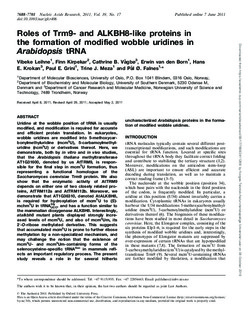| dc.contributor.author | Leihne, VIbeke | |
| dc.contributor.author | Kirpekar, F | |
| dc.contributor.author | Vågbø, Cathrine Broberg | |
| dc.contributor.author | Van den Born, Erwin | |
| dc.contributor.author | Krokan, Hans Einar | |
| dc.contributor.author | Grini, Paul Eivind | |
| dc.contributor.author | Meza, Trine Johansen | |
| dc.contributor.author | Falnes, Pål | |
| dc.date.accessioned | 2019-10-09T12:49:06Z | |
| dc.date.available | 2019-10-09T12:49:06Z | |
| dc.date.created | 2011-12-14T14:27:33Z | |
| dc.date.issued | 2011 | |
| dc.identifier.citation | Nucleic Acids Research. 2011, 39 (17), 7688-7701. | nb_NO |
| dc.identifier.issn | 0305-1048 | |
| dc.identifier.uri | http://hdl.handle.net/11250/2621206 | |
| dc.description.abstract | Uridine at the wobble position of tRNA is usually modified, and modification is required for accurate and efficient protein translation. In eukaryotes, wobble uridines are modified into 5-methoxycarbonylmethyluridine (mcm 5 U), 5-carbamoylmethyluridine (ncm 5 U) or derivatives thereof. Here, we demonstrate, both by in vitro and in vivo studies, that the Arabidopsis thaliana methyltransferase AT1G31600, denoted by us AtTRM9, is responsible for the final step in mcm 5 U formation, thus representing a functional homologue of the Saccharomyces cerevisiae Trm9 protein. We also show that the enzymatic activity of AtTRM9 depends on either one of two closely related proteins, AtTRM112a and AtTRM112b. Moreover, we demonstrate that AT1G36310, denoted AtALKBH8, is required for hydroxylation of mcm 5 U to ( S ) - mchm 5 U in tRNA GlyUCC , and has a function similar to the mammalian dioxygenase ALKBH8. Interestingly, atalkbh8 mutant plants displayed strongly increased levels of mcm 5 U, and also of mcm 5 Um, its 2′- O -ribose methylated derivative. This suggests that accumulated mcm 5 U is prone to further ribose methylation by a non-specialized mechanism, and may challenge the notion that the existence of mcm 5 U- and mcm 5 Um-containing forms of the selenocysteine-specific tRNA Sec in mammals reflects an important regulatory process. The present study reveals a role in for several hitherto uncharacterized Arabidopsis proteins in the formation of modified wobble uridines. | nb_NO |
| dc.language.iso | eng | nb_NO |
| dc.publisher | Oxford University Press | nb_NO |
| dc.rights | Navngivelse-Ikkekommersiell 4.0 Internasjonal | * |
| dc.rights.uri | http://creativecommons.org/licenses/by-nc/4.0/deed.no | * |
| dc.title | Roles of Trm9-and ALKBH8-like proteins in the formation of modified wobble uridines in Arabidopsis tRNA | nb_NO |
| dc.type | Journal article | nb_NO |
| dc.type | Peer reviewed | nb_NO |
| dc.description.version | publishedVersion | nb_NO |
| dc.source.pagenumber | 7688-7701 | nb_NO |
| dc.source.volume | 39 | nb_NO |
| dc.source.journal | Nucleic Acids Research | nb_NO |
| dc.source.issue | 17 | nb_NO |
| dc.identifier.doi | 10.1093/nar/gkr406 | |
| dc.identifier.cristin | 868029 | |
| dc.description.localcode | © The Author(s) 2011. Published by Oxford University Press. This is an Open Access article distributed under the terms of the Creative Commons Attribution Non-Commercial License (http://creativecommons.org/licenses/by-nc/3.0), which permits unrestricted non-commercial use, distribution, and reproduction in any medium, provided the original work is properly cited | nb_NO |
| cristin.unitcode | 194,65,15,0 | |
| cristin.unitname | Institutt for klinisk og molekylær medisin | |
| cristin.ispublished | true | |
| cristin.fulltext | original | |
| cristin.qualitycode | 2 | |

